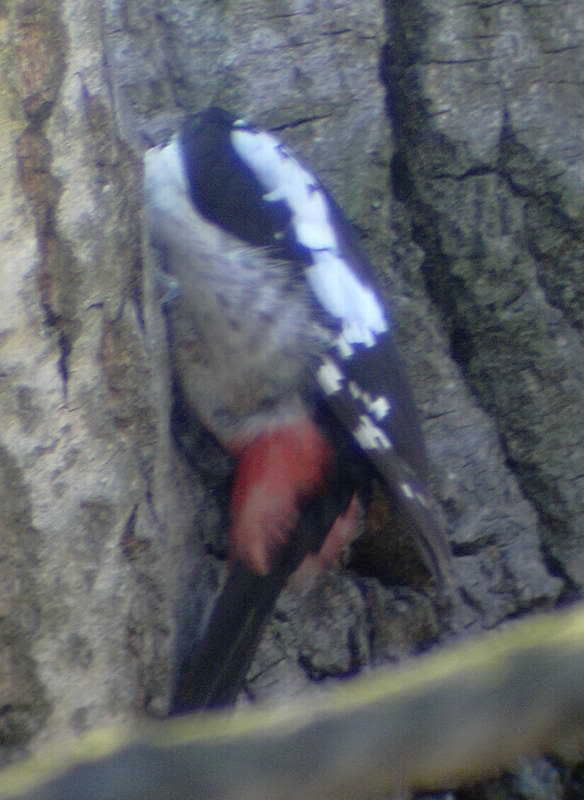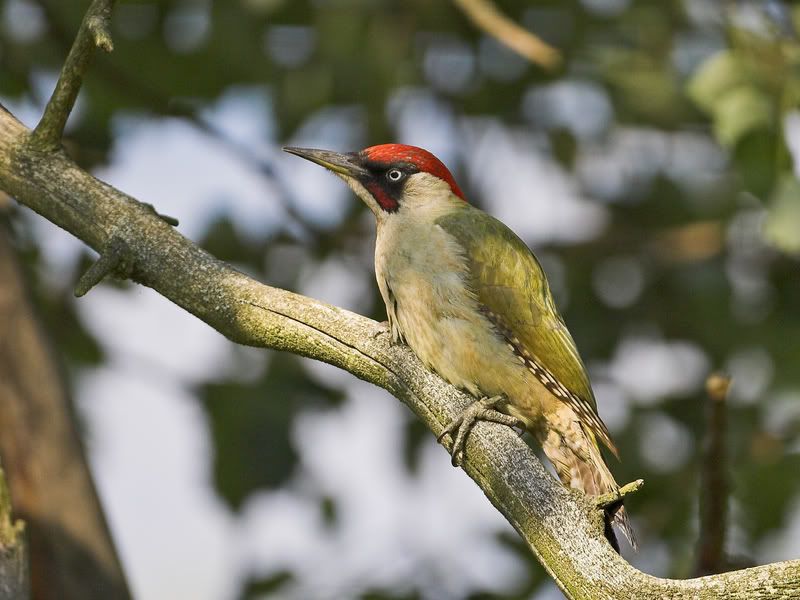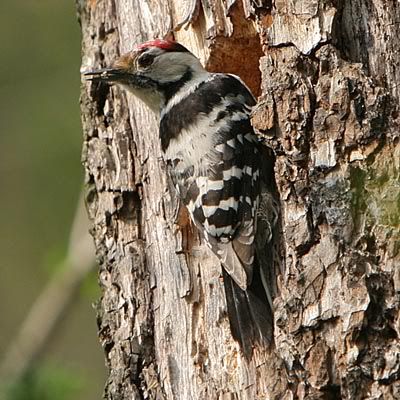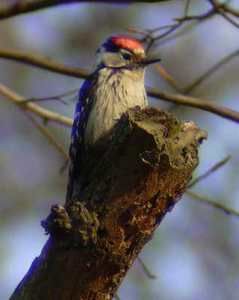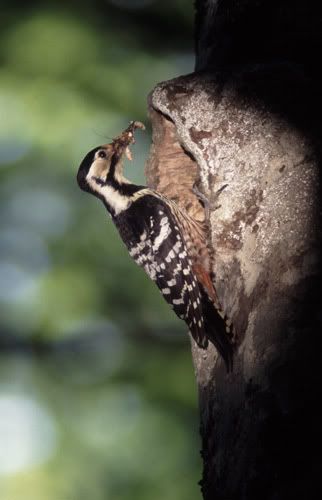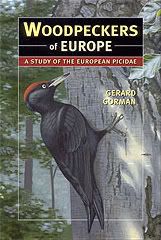 This shot of a female Black Woodpecker foraging recently in Hungary is by Dan Bastaja. Note the red is only on the hind crown (rather than on the whole crown as on males). In most winters, woodpeckers rove a little more than at other times of year and are often more approachable as they forage in difficult conditions. Black Woodpeckers will come down to the ground to feed and are often first located by the sound of the solid, single "knocks" they make on timber. If carefully approached they will remain and feed where they are. This foraging site is clearly a fairly new one, judging by the freshness of the hacked away timber. Snow rarely presents a problem to Black Woodpeckers as long as it is not several feet deep. They will swish snow away with sideways blows of their large bill to get at hibernating invertebrates, such as ants, in timber beneath.
This shot of a female Black Woodpecker foraging recently in Hungary is by Dan Bastaja. Note the red is only on the hind crown (rather than on the whole crown as on males). In most winters, woodpeckers rove a little more than at other times of year and are often more approachable as they forage in difficult conditions. Black Woodpeckers will come down to the ground to feed and are often first located by the sound of the solid, single "knocks" they make on timber. If carefully approached they will remain and feed where they are. This foraging site is clearly a fairly new one, judging by the freshness of the hacked away timber. Snow rarely presents a problem to Black Woodpeckers as long as it is not several feet deep. They will swish snow away with sideways blows of their large bill to get at hibernating invertebrates, such as ants, in timber beneath.Thursday, 20 December 2007
Black Woodpecker foraging in winter
 This shot of a female Black Woodpecker foraging recently in Hungary is by Dan Bastaja. Note the red is only on the hind crown (rather than on the whole crown as on males). In most winters, woodpeckers rove a little more than at other times of year and are often more approachable as they forage in difficult conditions. Black Woodpeckers will come down to the ground to feed and are often first located by the sound of the solid, single "knocks" they make on timber. If carefully approached they will remain and feed where they are. This foraging site is clearly a fairly new one, judging by the freshness of the hacked away timber. Snow rarely presents a problem to Black Woodpeckers as long as it is not several feet deep. They will swish snow away with sideways blows of their large bill to get at hibernating invertebrates, such as ants, in timber beneath.
This shot of a female Black Woodpecker foraging recently in Hungary is by Dan Bastaja. Note the red is only on the hind crown (rather than on the whole crown as on males). In most winters, woodpeckers rove a little more than at other times of year and are often more approachable as they forage in difficult conditions. Black Woodpeckers will come down to the ground to feed and are often first located by the sound of the solid, single "knocks" they make on timber. If carefully approached they will remain and feed where they are. This foraging site is clearly a fairly new one, judging by the freshness of the hacked away timber. Snow rarely presents a problem to Black Woodpeckers as long as it is not several feet deep. They will swish snow away with sideways blows of their large bill to get at hibernating invertebrates, such as ants, in timber beneath.Saturday, 15 December 2007
Grey-headed (Grey-faced) Woodpecker: foraging on rock walls
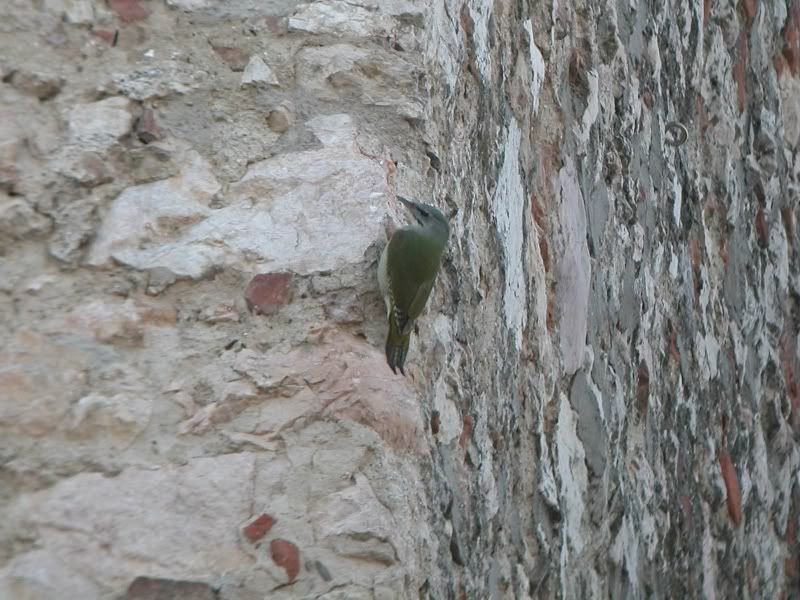 Grey-headed Woodpecker Picus canus will cling to rock faces, quarry walls, and even buildings. This species does this more than any other European picid. In fact, I would say that this foraging technique is common. The birds are foraging for insects, spiders and other invertebrates, examining cracks and crevices. These two photos show different females in stone quarries in Hungary, First taken by Gabor Vasuta, second by Szabolcs Kokay. In both photos note how the central tail feathers are used to good effect as props, as is done when on trees.
Grey-headed Woodpecker Picus canus will cling to rock faces, quarry walls, and even buildings. This species does this more than any other European picid. In fact, I would say that this foraging technique is common. The birds are foraging for insects, spiders and other invertebrates, examining cracks and crevices. These two photos show different females in stone quarries in Hungary, First taken by Gabor Vasuta, second by Szabolcs Kokay. In both photos note how the central tail feathers are used to good effect as props, as is done when on trees.
Tuesday, 11 December 2007
Anatomy, structure: feet
 Like most tree-dwelling birds, woodpeckers have zygodactyl feet. That is, they have four toes arranged in the so-called "yoke" formation of two toes (digits 2 and 3) pointing fowards and two pointing backwards (digits 1 and 4). However, this yoke formation (a kind of "X" shape) changes when woodpeckers climb as their feet are rotated with digit 4 usually held in a lateral position. In Europe Three-toed Woodpecker is the exception (hence the name) as it has completely lost digit 1. In fact, all woodpeckers are "three-toed" in terms of using their toes, as digit 1 is very short and almost redundant. All woodpeckers have relatively short legs and feet and their toes are tipped by strong claws. These adaptations are related to their arboreal lifestyle. The sharp claws are ideal for gripping tree surfaces, even very smooth bark, as in this photo of a Middle Spotted Woodpecker (taken in Hungary by Dan Bastaja).
Like most tree-dwelling birds, woodpeckers have zygodactyl feet. That is, they have four toes arranged in the so-called "yoke" formation of two toes (digits 2 and 3) pointing fowards and two pointing backwards (digits 1 and 4). However, this yoke formation (a kind of "X" shape) changes when woodpeckers climb as their feet are rotated with digit 4 usually held in a lateral position. In Europe Three-toed Woodpecker is the exception (hence the name) as it has completely lost digit 1. In fact, all woodpeckers are "three-toed" in terms of using their toes, as digit 1 is very short and almost redundant. All woodpeckers have relatively short legs and feet and their toes are tipped by strong claws. These adaptations are related to their arboreal lifestyle. The sharp claws are ideal for gripping tree surfaces, even very smooth bark, as in this photo of a Middle Spotted Woodpecker (taken in Hungary by Dan Bastaja).
Saturday, 8 December 2007
Anatomy, structure: tail

Most woodpeckers have rigid, strong central tail feathers which they use as props and supports when on tree trunks and branches. A sold, firm posture is important when a woodpecker is hacking at timber and the strong tail helps provide this. Note how the tail feathers on this male Black Woodpecker (photo by Gabor Vasuta, Hungary) are splayed and pressed against the branch, acting as stabalisers. The bird is not really perched, but rather presssed against the branch.
Friday, 7 December 2007
Anatomy, structure
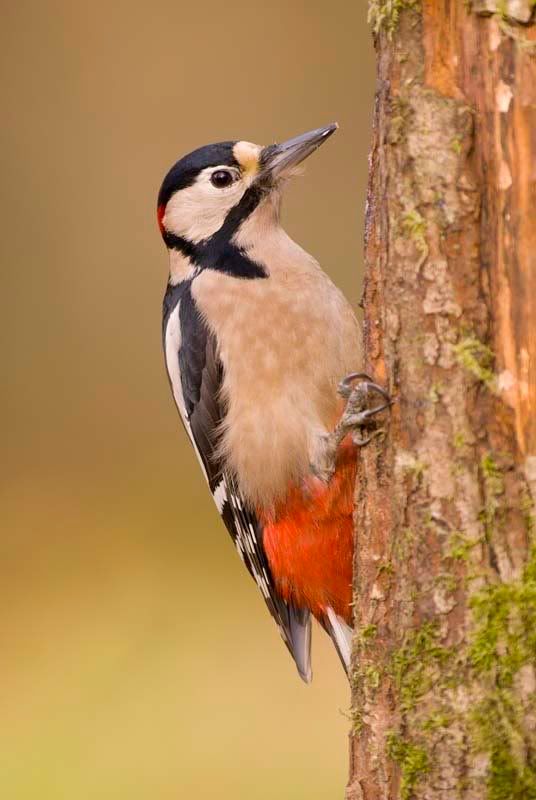 Woodpeckers are robustly built birds. They have a unique anatomy that enables them to exploit habitat and food niches that are unavailable to most other birds, and indeed many mammals. They have evolved many anatomical and structural features that allow them to cling to and climb up and down wood surfaces (which are often smooth) and hack into timber. These features include muscular bodies, tough skin, enlarged and adapted skulls, relatively large ribs, broad tendons, ridged chisel-shaped bills, strong feet, sharp claws, particularly strong tail feathers, and many others.
Woodpeckers are robustly built birds. They have a unique anatomy that enables them to exploit habitat and food niches that are unavailable to most other birds, and indeed many mammals. They have evolved many anatomical and structural features that allow them to cling to and climb up and down wood surfaces (which are often smooth) and hack into timber. These features include muscular bodies, tough skin, enlarged and adapted skulls, relatively large ribs, broad tendons, ridged chisel-shaped bills, strong feet, sharp claws, particularly strong tail feathers, and many others.Many of these features can be seen well on this photo of Great Spotted Woodpecker here, taken in Sussex, England by David Plummer: http://www.davidplummerimages.co.uk/
Note the broad chisel-shaped bill with a sharp tip, The robust legs and feet with long sharp claws and the overall stout, strong body.
Thursday, 6 December 2007
Signs: acorns
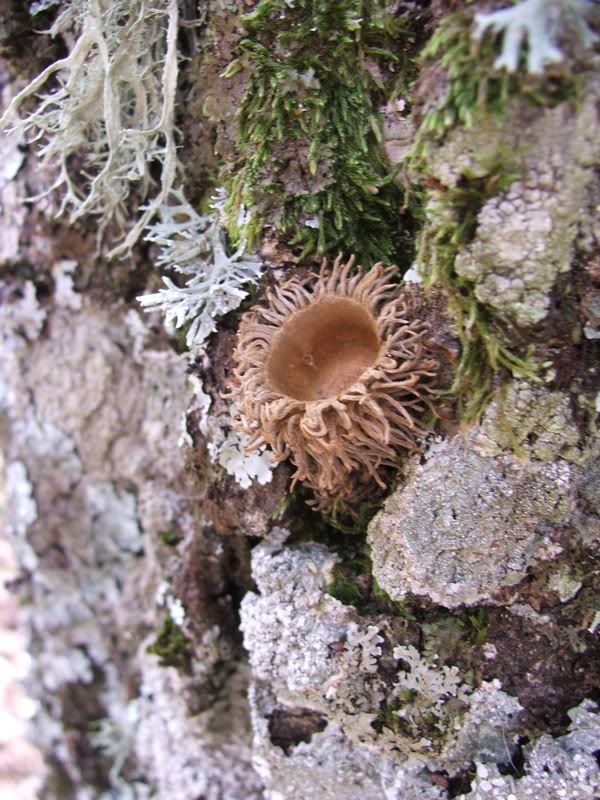 These photos of acorns wedged into crevices in tree trunks were taken by Adriano Castelmezzano in the Pollino area in Basilicata, southern Italy. These "anvils" or "workshops" were situated very low down on the trees, just above the ground. Food items such as these (and pine cones) are wedged into position and hacked open in situ. It is not always possible to say with certainty that such work has not been done by a Nuthatch Sitta europaea but it is more likely the work of a Great Spotted Woodpecker. Beak marks, which are not clear here, are often the best clue. The only other European woodpecker that regularly works with food items in this way is Syrian Woodpecker, and this species is not present in Italy.
These photos of acorns wedged into crevices in tree trunks were taken by Adriano Castelmezzano in the Pollino area in Basilicata, southern Italy. These "anvils" or "workshops" were situated very low down on the trees, just above the ground. Food items such as these (and pine cones) are wedged into position and hacked open in situ. It is not always possible to say with certainty that such work has not been done by a Nuthatch Sitta europaea but it is more likely the work of a Great Spotted Woodpecker. Beak marks, which are not clear here, are often the best clue. The only other European woodpecker that regularly works with food items in this way is Syrian Woodpecker, and this species is not present in Italy.
Wednesday, 5 December 2007
Syrian and Great Spotted Woodpeckers excavating together
 Not only did the female Syrian Woodpecker in the previous post (below) show unusual plumage, but she was also associated with a male Great Spotted Woodpecker, forming a pair. Together, the female Syrian and male Great Spotted excavated a nest-hole, in a false acacia (robinia) tree at Apaj, SE of Budapest, Hungary. Unfortunately, it is not known whether this pair subsequently mated and produced any young. Here are more photos, by Bence Kokay: 1st: female Syrian Woodpecker. 2nd: male Great Spotted Woodpecker.
Not only did the female Syrian Woodpecker in the previous post (below) show unusual plumage, but she was also associated with a male Great Spotted Woodpecker, forming a pair. Together, the female Syrian and male Great Spotted excavated a nest-hole, in a false acacia (robinia) tree at Apaj, SE of Budapest, Hungary. Unfortunately, it is not known whether this pair subsequently mated and produced any young. Here are more photos, by Bence Kokay: 1st: female Syrian Woodpecker. 2nd: male Great Spotted Woodpecker.
Tuesday, 4 December 2007
Syrian Woodpecker: unusual plumage
 The more I study woodpeckers, the more unusual things I find. European woodpeckers, especially the Dendrocopos species, the so-called "pied woodpeckers" often show unusual, atypical plumage features. Sometimes, the are so striking that it is hard to decide whether a bird is a hybrid of some kind or simply atypical. Most of the unusual plumages I have seen concern Great Spotted Woodpecker and Syrian Woodpecker. The photo here shows an adult female Syrian Woodpecker, taken at a nest-hole at Apaj, Hungary, by Bence Kokay, in spring 2007 (more on this nest in subsequent post). Note that the bird has a small red spot on the hindcrown, low down on the left side. Of course, female Syrians should not show any red on the crown, though juvenile females do. Are these red feather tips remnants of the bird's juvenile plumage ? Or is there another explanation ?
The more I study woodpeckers, the more unusual things I find. European woodpeckers, especially the Dendrocopos species, the so-called "pied woodpeckers" often show unusual, atypical plumage features. Sometimes, the are so striking that it is hard to decide whether a bird is a hybrid of some kind or simply atypical. Most of the unusual plumages I have seen concern Great Spotted Woodpecker and Syrian Woodpecker. The photo here shows an adult female Syrian Woodpecker, taken at a nest-hole at Apaj, Hungary, by Bence Kokay, in spring 2007 (more on this nest in subsequent post). Note that the bird has a small red spot on the hindcrown, low down on the left side. Of course, female Syrians should not show any red on the crown, though juvenile females do. Are these red feather tips remnants of the bird's juvenile plumage ? Or is there another explanation ?
Monday, 3 December 2007
Quiz woodpecker 8
Middle Spotted Woodpecker, Abruzzo NP, Italy
 This photo, taken by my fellow woodpecker enthusiast Paul Harris in mid-June 2007, is very important. It shows a Middle Spotted Woodpecker Dendrocopos medius with food in its bill at a nest hole in the Abruzzo National Park, central Italy. This species is very rare indeed in that area: this is only the 3rd nest ever found in the Abruzzo, the other two being found in the early 1980s.
This photo, taken by my fellow woodpecker enthusiast Paul Harris in mid-June 2007, is very important. It shows a Middle Spotted Woodpecker Dendrocopos medius with food in its bill at a nest hole in the Abruzzo National Park, central Italy. This species is very rare indeed in that area: this is only the 3rd nest ever found in the Abruzzo, the other two being found in the early 1980s.
Friday, 30 November 2007
Woodpecker artwork 2
 Female Syrian Woodpecker at the nest hole, feeding chick, in Budapest. Oil on canvas by Szabolcs Kokay: http://kokayart.blogspot.com/
Female Syrian Woodpecker at the nest hole, feeding chick, in Budapest. Oil on canvas by Szabolcs Kokay: http://kokayart.blogspot.com/
Friday, 23 November 2007
Thursday, 22 November 2007
Tuesday, 20 November 2007
Drumming
Drumming is a form of song, a method of communication that only woodpeckers produce. It is not, as is sometimes presumed, a foraging technique or part of nest hole excavation work. Though woodpeckers make noises on wood with their bills in other ways (when excavating holes and when feeding) this is not drumming. The sounds made by drumming are actually quite simple and though drumming replaces song (as we know it for passerines) it is less complicated. Nine out of ten of Europe’s woodpecker species drum in the true sense. Wrynecks sometimes appear to drum by their nest-holes, very lightly and probably to advertise the site to partner, or to confirm ownership, but this is rarely heard or observed. Wrynecks also occasionally tap at trees but this behaviour may be linked to foraging rather than to communication. Drumming is a very fast series of strikes done with the bill on a hard surface. The special anatomy of the skull facilitates this potentially dangerous behaviour. Muscles in the head and neck contract just before impact and in the process absorb the shock waves made by the drumming. Woodpeckers choose certain areas of a tree (or other surface) and drum there to announce or confirm their presence and claim to territory. They may also drum when alarmed or agitated. Woodpeckers have several favourite drumming posts in their breeding territories and regularly visit and use them in the pre-breeding period. Dry, dead snags and branches are most often used, probably because they resonate better. Drumming posts are always located high up, almost certainly because woodpeckers know that the sound will carry further. Drumming is, and must be, far carrying and this is achieved also by woodpeckers choosing drumming posts, such as hollow snags, that have good acoustic properties. This probably explains why artificial surfaces such as lamp-poles and satellite dishes are sometimes used. Drumming is rarely done on windy days, perhaps because birds have realised the futility of it. Drumming is seasonal and as it replaces song it is mainly, but not only, carried out in the pre-breeding period. It is reduced when pairs are formed. Drumming by male woodpeckers also attracts females and declares to other males that a territory is claimed and occupied. In the pre-courtship phase of breeding Black Woodpeckers, for example, a male will drum hundreds of times per day. Females probably drum in order to keep in contact with males and to reinforce the pair bond and declare territorial rights to other pairs. Some species, especially those with larger territories like White-backed and Black Woodpeckers, indulge in long-distance communication by drumming. Most species also indulge in some light drumming just after leaving or before entering the roost hole and this may be done all year round. Drumming is species specific. The number of beats per second, the cadence, and the rhythm of the phrase can be diagnostic. Other things to consider are duration, intensity, interval between strikes (speed) and changes in tempo. Some species, such as Great Spotted, drum in a rhythmic pattern; others such as Black Woodpecker produce strong, solid bursts. Lesser Spotted Woodpeckers produce more of a rattle than a drum. There is a relationship between the size of the woodpecker drumming and the volume of the drumming, however the volume and quality of any drumming is also dependent upon the surface and condition of the drumming post.
Monday, 19 November 2007
Woodpecker flight
 It is often said, and written, that woodpeckers are poor, weak fliers. This is not really true. If need be, woodpeckers can travel quite long distances and are not afraid to cross exapanses of open ground or even large bodies of water, such as lakes and even the sea. Some species, such as White-backed and Great Spotted, can disperse for hundeds of kms in hard winters, in search of food resources. The so-called "typical" woodpecker flight of a series of fast wing beats followed by a bound, creating an undulating flight pattern, is not true for all species. Green Woodpecker perhaps illustrates this flight pattern best, the Dendrocopos woodpeckers bound, to varying degrees, in flight, but Wrynecks and Black Woodpecker, for example, do not fly like this. The two photos here show a Black Woodpecker in the Danube Delata, Romania, by Daniel Petrescu.
It is often said, and written, that woodpeckers are poor, weak fliers. This is not really true. If need be, woodpeckers can travel quite long distances and are not afraid to cross exapanses of open ground or even large bodies of water, such as lakes and even the sea. Some species, such as White-backed and Great Spotted, can disperse for hundeds of kms in hard winters, in search of food resources. The so-called "typical" woodpecker flight of a series of fast wing beats followed by a bound, creating an undulating flight pattern, is not true for all species. Green Woodpecker perhaps illustrates this flight pattern best, the Dendrocopos woodpeckers bound, to varying degrees, in flight, but Wrynecks and Black Woodpecker, for example, do not fly like this. The two photos here show a Black Woodpecker in the Danube Delata, Romania, by Daniel Petrescu. Friday, 16 November 2007
Colour plates from Woodpeckers of Europe
Wednesday, 14 November 2007
Woodpecker artwork
 I would like to introduce you to the work of my good friend Szabolcs Kokay. He is a young Hungarian wildlife artist who illustrated my book WOODPECKERS OF EUROPE. Those plates and sketches are the best I have seen on European woodpeckers. Here is a sample of his superb work, a male Black Woodpecker. Take a look at his blog to see more... http://kokayart.blogspot.com/
I would like to introduce you to the work of my good friend Szabolcs Kokay. He is a young Hungarian wildlife artist who illustrated my book WOODPECKERS OF EUROPE. Those plates and sketches are the best I have seen on European woodpeckers. Here is a sample of his superb work, a male Black Woodpecker. Take a look at his blog to see more... http://kokayart.blogspot.com/
Friday, 5 October 2007
Quiz Woodpecker 6
Sunday, 30 September 2007
Quiz Woodpecker 5
Friday, 28 September 2007
Woodpeckers: juvenile moult
Juvenile woodpeckers begin a partial post juvenile moult at around the time of fledging and this continues until the autumn. In this first moult, juveniles of all ten European woodpecker species replace their primaries, rectrices and overall (body) plumage but some tertials, secondaries, primary coverts and outer greater coverts are retained. One of the ways to age 1st winter birds is the fact that there is often a moult limit in the greater coverts. For example, in Great Spotted Woodpecker where the new adult-type black inner greater coverts, contrast with the old juvenile brownish outer greater coverts. Juveniles have shorter tails than adults, due to all but the central pair of rectrices being shorter than on adults. The odd looking stunted tail of juvenile Black Woodpeckers in flight is due to this tail arrangement. Another interesting case involves Three-toed Woodpecker. Juveniles of this species sometimes begin their moult while still in the nesting cavity. Interestingly, the fifth to seventh innermost primaries are grown and replaced before the birds have fledged and thus they have never been used. This apparent rush to moult is almost certainly an adaptive feature, the result of the need of the species, as a bird of mainly northern latitudes, to complete the moulting task before the end of the short summer season. When the harsh winter season begins birds must be ready to disperse at short notice to new foraging areas, often some distance away, and a delay while moult is completed could prove fatal. For similar reasons, suspended moult occurs in local populations of other species that are prone to eruptive movements such as Fenno-Scandic and Russian Great Spotted Woodpeckers. Juveniles trapped in Fenno-Scandia after arriving from further east in late autumn apparently often exhibit signs of suspended moult in the tail and wing when compared to resident birds. Moult is then resumed sometimes as late as December.
Woodpecker moult
The moult regime of the true woodpeckers is rather unusual and this is related to the lifestyle of the family, in particular to foraging habits and to the breeding cycle. A typical European woodpecker (all except Wryneck) has ten primaries, eleven secondaries, and twelve tail feathers. Primaries 6, 7 and 8 are the longest and P10 is reduced in size in adults but is longer and broader in juveniles. Most adult woodpeckers begin a complete post-breeding moult in late spring or early summer soon after breeding has finished and this lasts into autumn. Primaries are moulted sequentially (ascendant) from P1 and the secondaries from two centres (ascendantly from S1, ascendantly and descendantly from S8). The outermost rectrices are also much shorter than the other tail feathers, the central two being the longest. These two feathers are so important as props when climbing and clinging to vertical surfaces, so they are replaced last, after the other tail feathers. Counting the central two as R1 moult starts ascendantly in pairs from R2 to R6 with R1 last. There is no pre-breeding moult for the true woodpeckers, though Wryneck has a partial pre-breeding moult. Wrynecks moult their tail feathers in reversed sequence.
Wednesday, 26 September 2007
Monday, 24 September 2007
Holes: White-backed Woodpecker - natural hole use
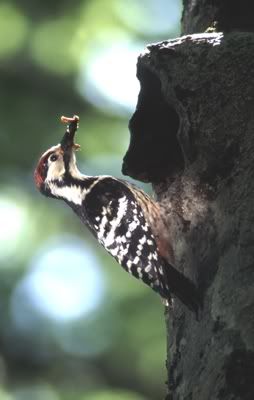 This important photo shows an adult male White-backed Woodpecker (lilfordi race) in the Abruzzo mountains, central Italy (Paul Harris). This is a very interesting shot indeed as it captures the bird using a natural tree hole as a nesting site. It is very rare for a European woodpecker (except Wryneck) to nest in a tree-hole which it did not create itself. Though the entrance is "natural" it is thought that this White-backed pair pair adapted and enlarged the cavity to suit their needs. This breeding site was also successful, note the male has food items in his beak which he is about to offer to the chicks inside the cavity.
This important photo shows an adult male White-backed Woodpecker (lilfordi race) in the Abruzzo mountains, central Italy (Paul Harris). This is a very interesting shot indeed as it captures the bird using a natural tree hole as a nesting site. It is very rare for a European woodpecker (except Wryneck) to nest in a tree-hole which it did not create itself. Though the entrance is "natural" it is thought that this White-backed pair pair adapted and enlarged the cavity to suit their needs. This breeding site was also successful, note the male has food items in his beak which he is about to offer to the chicks inside the cavity.
Holes: White-backed Woodpecker
 This photo shows an adult male White-backed Woodpecker (lilfordi race) in the Abruzzo mountains, central Italy (Paul Harris). Note the almost perfectly round cavity entrance, which is typical for many species including White-backed. The paleness of the exposed wood in the entrance hole indicates the "newness" of the cavity. Indeed, woodpeckers excavate fresh, new nesting holes every spring, though occasionally an old hole will be re-used, presumably after it has proven to be a success, safe nest site. Used cavities often remain clean, as woodpeckers are hygenic breeders removing the droppings of their chicks as they grow, and thus can be re-used (by the woodpeckers who made it or by secondary cavity breeders). White-backed Woodpeckers rarely re-use a hole. This is probably because their holes often do not survive from one spring to the next as they are invariably made in very rotten trees which decay rapidly and become unstable.
This photo shows an adult male White-backed Woodpecker (lilfordi race) in the Abruzzo mountains, central Italy (Paul Harris). Note the almost perfectly round cavity entrance, which is typical for many species including White-backed. The paleness of the exposed wood in the entrance hole indicates the "newness" of the cavity. Indeed, woodpeckers excavate fresh, new nesting holes every spring, though occasionally an old hole will be re-used, presumably after it has proven to be a success, safe nest site. Used cavities often remain clean, as woodpeckers are hygenic breeders removing the droppings of their chicks as they grow, and thus can be re-used (by the woodpeckers who made it or by secondary cavity breeders). White-backed Woodpeckers rarely re-use a hole. This is probably because their holes often do not survive from one spring to the next as they are invariably made in very rotten trees which decay rapidly and become unstable.
Holes: secondary user - Tengmalm's Owl
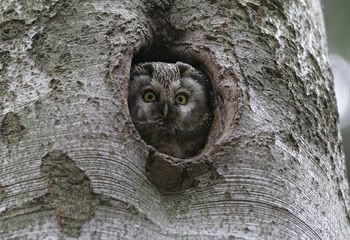 This photo shows a Tengmalm's Owl (Boreal Owl) using an old Black Woodpecker nest-hole in a beech tree as a nesting site. Taken in the Sumava mountains, South Bohemia, Czech Republic, April 2005 (Dave Pullen). This site has been repeatably used for many years by the owls, possibly several generations of the family. The hole is so old that it has been weathered by the elements and the timber "healed". It thus appears almost natural i.e. note the rounded smooth entrance. In 2007 the hole was occupied by wasps and the owls moved on.
This photo shows a Tengmalm's Owl (Boreal Owl) using an old Black Woodpecker nest-hole in a beech tree as a nesting site. Taken in the Sumava mountains, South Bohemia, Czech Republic, April 2005 (Dave Pullen). This site has been repeatably used for many years by the owls, possibly several generations of the family. The hole is so old that it has been weathered by the elements and the timber "healed". It thus appears almost natural i.e. note the rounded smooth entrance. In 2007 the hole was occupied by wasps and the owls moved on.
Holes: Black Woodpecker as a provider
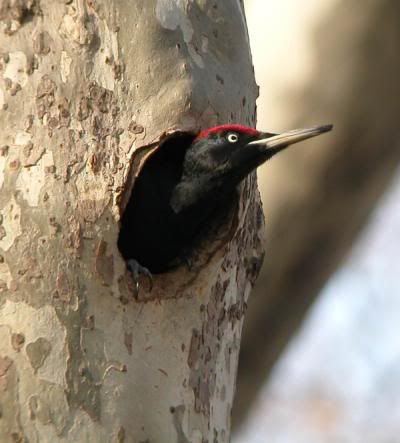 Almost all of Europe’s woodpeckers play a role in providing nest and roost sites for other wildlife. Woodpeckers are primary hole users, that is, they excavate their own holes. Species that do not make their own holes, but rather use those made by others, are known as secondary cavity users. Black Woodpecker is Europe's largest primary excavator. This species can be regarded as a very important species as a provider of tree holes for other animals This is quite simply because this is the only bird in Europe’s forests that can excavate large holes in sound trees. Many species, avian and others, that are unable to do bore into timber use these holes for breeding and roosting. In fact, the distribution and success of these species often depends upon the Black Woodpecker. Birds which commonly use old Black Woodpecker as nest-sites include Stock Dove, Jackdaw and Tengmalm's Owl, whilst mammals include Red Squirrel, Pine Marten and various bats. The photo here shows an adult male Black Woodpecker leaving its hole in a park in Budapest, Hungary (Gábor Vasuta). Note the oval rather than round shape of the entrance which is typical for this species.
Almost all of Europe’s woodpeckers play a role in providing nest and roost sites for other wildlife. Woodpeckers are primary hole users, that is, they excavate their own holes. Species that do not make their own holes, but rather use those made by others, are known as secondary cavity users. Black Woodpecker is Europe's largest primary excavator. This species can be regarded as a very important species as a provider of tree holes for other animals This is quite simply because this is the only bird in Europe’s forests that can excavate large holes in sound trees. Many species, avian and others, that are unable to do bore into timber use these holes for breeding and roosting. In fact, the distribution and success of these species often depends upon the Black Woodpecker. Birds which commonly use old Black Woodpecker as nest-sites include Stock Dove, Jackdaw and Tengmalm's Owl, whilst mammals include Red Squirrel, Pine Marten and various bats. The photo here shows an adult male Black Woodpecker leaving its hole in a park in Budapest, Hungary (Gábor Vasuta). Note the oval rather than round shape of the entrance which is typical for this species.
Saturday, 22 September 2007
Holes: location
 Holes are generally placed as high as possible and two factors probably contribute to this. Firstly, a high location means more protection from general disturbance and predators. Secondly, wood is newer and hence softer in higher sections of trunk than it is lower down and thus excavation is easier. When a pair of woodpeckers nest at low levels, in stumps for example, it is probably because of a lack of suitable high locations. The softest parts of a tree are usually chosen, though the outer layers of the tree must be strong and rigid enough to support the cavity. Thus, the perfect location will combine a hard outer protective shell and a soft, rotten core that can be easily excavated. And another trade-off exists: the hardness of wood decreases as trees die thus live trees may provide a sound shell but are harder to excavate, whilst rotten trees are easier to excavate but may not provide a strong enough outer structure to support a cavity. Strong winds snap trees off at the weakest point and this is often the spot where a woodpecker cavity has been excavated. It is unclear how woodpeckers identify suitable nesting trees, that is, how they know which trees contain soft heartwood. It is probable that a combination of visual clues, such as fungal growths and already existing holes and the sounding out of wood with taps are combined. Whenever possible soft tree species like pine and aspen are used. Despite the formidable chisel-like bill that woodpeckers have, they seemingly do not like to do more excavating than is necessary. In hilly landscapes Europe’s woodpeckers usually excavate their nests on south-facing slopes. Holes in trees situated in open areas are more likely to be placed on the north facing side than those inside woodland. It has been suggested that this is to minimize overheating by the sun. Besides compass direction, other factors influence the location of holes on trees. A very important factor seems to be height. In my experience, when a nest tree is on a slope, holes placed in it will face away from the slope, regardless of compass direction. This may be because a hole facing downhill will always be higher than one on the opposite side of the trunk facing uphill and this offers better protection from predators. Indeed, I have never found a woodpecker hole of any species where the entrance faced uphill or inclined upwards. It has also been suggested that the reason why holes usually face outwards from slopes is because of a need for a "good lookout". This idea, too, is linked to the need to reduce risks from predators, which can be seen more easily and earlier. This photo of a juvenile Great Spotted Woodpecker was taken in England (Bill Baston). This is a rather worn entrance hole, and does not seem as tight a fit as is usual for woodpecker nest-hole entrances. Perhaps the rather rugged bark, and angle of the trunk made creating a close-fit difficult?
Holes are generally placed as high as possible and two factors probably contribute to this. Firstly, a high location means more protection from general disturbance and predators. Secondly, wood is newer and hence softer in higher sections of trunk than it is lower down and thus excavation is easier. When a pair of woodpeckers nest at low levels, in stumps for example, it is probably because of a lack of suitable high locations. The softest parts of a tree are usually chosen, though the outer layers of the tree must be strong and rigid enough to support the cavity. Thus, the perfect location will combine a hard outer protective shell and a soft, rotten core that can be easily excavated. And another trade-off exists: the hardness of wood decreases as trees die thus live trees may provide a sound shell but are harder to excavate, whilst rotten trees are easier to excavate but may not provide a strong enough outer structure to support a cavity. Strong winds snap trees off at the weakest point and this is often the spot where a woodpecker cavity has been excavated. It is unclear how woodpeckers identify suitable nesting trees, that is, how they know which trees contain soft heartwood. It is probable that a combination of visual clues, such as fungal growths and already existing holes and the sounding out of wood with taps are combined. Whenever possible soft tree species like pine and aspen are used. Despite the formidable chisel-like bill that woodpeckers have, they seemingly do not like to do more excavating than is necessary. In hilly landscapes Europe’s woodpeckers usually excavate their nests on south-facing slopes. Holes in trees situated in open areas are more likely to be placed on the north facing side than those inside woodland. It has been suggested that this is to minimize overheating by the sun. Besides compass direction, other factors influence the location of holes on trees. A very important factor seems to be height. In my experience, when a nest tree is on a slope, holes placed in it will face away from the slope, regardless of compass direction. This may be because a hole facing downhill will always be higher than one on the opposite side of the trunk facing uphill and this offers better protection from predators. Indeed, I have never found a woodpecker hole of any species where the entrance faced uphill or inclined upwards. It has also been suggested that the reason why holes usually face outwards from slopes is because of a need for a "good lookout". This idea, too, is linked to the need to reduce risks from predators, which can be seen more easily and earlier. This photo of a juvenile Great Spotted Woodpecker was taken in England (Bill Baston). This is a rather worn entrance hole, and does not seem as tight a fit as is usual for woodpecker nest-hole entrances. Perhaps the rather rugged bark, and angle of the trunk made creating a close-fit difficult?
Holes: used and unused
 The main period of hole excavating activity is in early spring, in the lead up to breeding. But this is not the only time of year when such work is done. After the chicks have fledged most adults begin to excavate more holes in the home range. These, and used nest holes, serve as roosts through the autumn and winter. Depending on the species it takes up to four weeks for a new hole and chamber to be completed, though in most cases two weeks is enough. Black and Great Spotted Woodpeckers will excavate holes in live trees, the other European woodpecker species rarely do so. Black Woodpecker is the only species that can excavate cavities in the sound, living wood of trees. All other species need either dead trees with rotten wood or live trees with heart rot. For all woodpeckers the quality and condition of wood is more important than tree species. Whether good excavators or not all species seem to depend upon the heart of the tree or core of the branch being softer than the surface. Many trees which are sound on the outside may be soft at the core due to fungi such as heart-rot and/or invertebrate activity. Much of the general tapping that woodpeckers do may be a "sounding out" technique where such wood suitable for excavation is discovered. It seems that creating a complete hole (entrance, tunnel and chamber) in completely sound wood seems to be just too much for even the best excavators. It is therefore common for a bird to abandon a site soon after starting work, probably when the bird realises that the timber chosen is hard to the core. It is not unusual for woodpecker-rich woodlands to be full of many apparent holes, which upon inspection prove to be just a few inches deep, merely entrances rather than chambers. The photo here of an adult male Lesser Spotted Woodpecker excavating a nest-hole, was taken in Chemnitz, Germany (Thomas Kraft). Wood-chips can be seen flying off the tree as the bird works. Note too, how the bird's tail is pressed against the trunk and thus acts as a stable prop.
The main period of hole excavating activity is in early spring, in the lead up to breeding. But this is not the only time of year when such work is done. After the chicks have fledged most adults begin to excavate more holes in the home range. These, and used nest holes, serve as roosts through the autumn and winter. Depending on the species it takes up to four weeks for a new hole and chamber to be completed, though in most cases two weeks is enough. Black and Great Spotted Woodpeckers will excavate holes in live trees, the other European woodpecker species rarely do so. Black Woodpecker is the only species that can excavate cavities in the sound, living wood of trees. All other species need either dead trees with rotten wood or live trees with heart rot. For all woodpeckers the quality and condition of wood is more important than tree species. Whether good excavators or not all species seem to depend upon the heart of the tree or core of the branch being softer than the surface. Many trees which are sound on the outside may be soft at the core due to fungi such as heart-rot and/or invertebrate activity. Much of the general tapping that woodpeckers do may be a "sounding out" technique where such wood suitable for excavation is discovered. It seems that creating a complete hole (entrance, tunnel and chamber) in completely sound wood seems to be just too much for even the best excavators. It is therefore common for a bird to abandon a site soon after starting work, probably when the bird realises that the timber chosen is hard to the core. It is not unusual for woodpecker-rich woodlands to be full of many apparent holes, which upon inspection prove to be just a few inches deep, merely entrances rather than chambers. The photo here of an adult male Lesser Spotted Woodpecker excavating a nest-hole, was taken in Chemnitz, Germany (Thomas Kraft). Wood-chips can be seen flying off the tree as the bird works. Note too, how the bird's tail is pressed against the trunk and thus acts as a stable prop.
Holes: safety
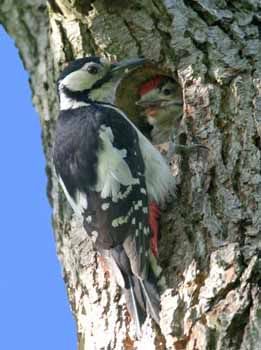 The photo here is of adult female Great Spotted Woodpecker feeding a well grown, and ready to fledge, juvenile at a nest-hole in England (Bill Baston). On this view the advantage of being raised in a cavity rather than in an open nest can be imagined: shelter from the elements and safety from most predators.
The photo here is of adult female Great Spotted Woodpecker feeding a well grown, and ready to fledge, juvenile at a nest-hole in England (Bill Baston). On this view the advantage of being raised in a cavity rather than in an open nest can be imagined: shelter from the elements and safety from most predators..
Friday, 21 September 2007
Holes
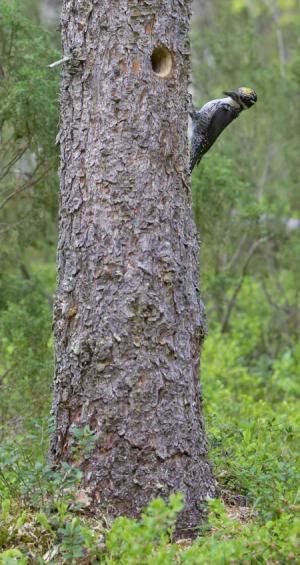 The ability that woodpeckers have of being able to excavate holes in trees is the one thing that really sets them apart from other birds. In Europe woodpeckers are primary hole-excavators, that is, they are the bird family that contributes most to the process of cavity making in forests. To be it simply THEY excavate their own holes, for breeding in and roosting in. The fact that woodpeckers can do this is one of the main reasons why they are successful. There are many advantages for both parents and chicks in being able to raise and be raised in the weatherproof haven of a chamber inside a tree. Being able to roost in such shelters is obviously an advantage for adults, too. This photo from Finland (Jari Peltomaki) shows a mlae Three-toed Woodpecker at the nest-hole. Note how the entrance hole is almost perfectly round. The hole is around one metre above ground level. Such a height is not unusual for this species though most other woodpecker species rarely nest this low. With experience many nest-holes (though not all) can be assigned to species without the bird beeing seen. When searching for woodpecker holes it should be kept in mind that it is the quality of the wood, rather than tree species, that dictates the chosen site, though some tree species are obviously preferred over others. In areas of Europe where several woodpecker species are sympatric this can mean six or even more species co-existing, and the forest riddled with various holes of differing sizes and shapes. I will discuss this further in subsequent posts.
The ability that woodpeckers have of being able to excavate holes in trees is the one thing that really sets them apart from other birds. In Europe woodpeckers are primary hole-excavators, that is, they are the bird family that contributes most to the process of cavity making in forests. To be it simply THEY excavate their own holes, for breeding in and roosting in. The fact that woodpeckers can do this is one of the main reasons why they are successful. There are many advantages for both parents and chicks in being able to raise and be raised in the weatherproof haven of a chamber inside a tree. Being able to roost in such shelters is obviously an advantage for adults, too. This photo from Finland (Jari Peltomaki) shows a mlae Three-toed Woodpecker at the nest-hole. Note how the entrance hole is almost perfectly round. The hole is around one metre above ground level. Such a height is not unusual for this species though most other woodpecker species rarely nest this low. With experience many nest-holes (though not all) can be assigned to species without the bird beeing seen. When searching for woodpecker holes it should be kept in mind that it is the quality of the wood, rather than tree species, that dictates the chosen site, though some tree species are obviously preferred over others. In areas of Europe where several woodpecker species are sympatric this can mean six or even more species co-existing, and the forest riddled with various holes of differing sizes and shapes. I will discuss this further in subsequent posts.
Green Woodpecker: photo of male
Thursday, 20 September 2007
Quiz Woodpecker 2
Wednesday, 19 September 2007
Lesser Spotted Woodpecker: adult male photo
Lesser Spotted Woodpecker: races ID
 There are clinal differences in the plumage and measurements of Lesser Spotted Woodpecker across its range. There are often clear differences between races in terms of size, pattern of plumage and colour tones, in particular the shade of white on the head. As a rule northern and eastern birds are paler and larger than southern and western ones. In Europe three groups can be defined in the hand. The nominate minor (Scandinavia to Urals) is the largest, longest tailed, longest winged and is overall whiter with less streaking on the flanks and less bars on the outer tail. Hortorum (most of continental Europe) is intermediate in wing length, is slightly smaller, with a slightly shorter tail. This race also has less white on the back, has darker and buffer under-parts, more flank streaking and the outer rectrices are more barred than on minor, the face appears dirty and some show a touch of pink on the throat and upper breast. Buturlini (Iberia, through Mediterranean zone to the Balkans), danfordi (Greece and Turkey) and comminutus (Britain) are darker and all short in the wing. On most danfordi birds the black post-auricular stripe comes close to, or even touches the nape. Most comminutus are largely plain white, lacking streaks below. This photo shows a nominate race (minor) adult male (note red on crown) in Sweden, in February 2005 (Göran Ekström). Note how the white underparts lack barring. Note also just two clear black bars on the outer tail feather.
There are clinal differences in the plumage and measurements of Lesser Spotted Woodpecker across its range. There are often clear differences between races in terms of size, pattern of plumage and colour tones, in particular the shade of white on the head. As a rule northern and eastern birds are paler and larger than southern and western ones. In Europe three groups can be defined in the hand. The nominate minor (Scandinavia to Urals) is the largest, longest tailed, longest winged and is overall whiter with less streaking on the flanks and less bars on the outer tail. Hortorum (most of continental Europe) is intermediate in wing length, is slightly smaller, with a slightly shorter tail. This race also has less white on the back, has darker and buffer under-parts, more flank streaking and the outer rectrices are more barred than on minor, the face appears dirty and some show a touch of pink on the throat and upper breast. Buturlini (Iberia, through Mediterranean zone to the Balkans), danfordi (Greece and Turkey) and comminutus (Britain) are darker and all short in the wing. On most danfordi birds the black post-auricular stripe comes close to, or even touches the nape. Most comminutus are largely plain white, lacking streaks below. This photo shows a nominate race (minor) adult male (note red on crown) in Sweden, in February 2005 (Göran Ekström). Note how the white underparts lack barring. Note also just two clear black bars on the outer tail feather.
Lesser Spotted Woodpecker: juvenile ID
 Juvenile Lesser Spotted Woodpeckers are overall duller than adults. Black areas are less glossy, rather matt, and often with a tinge of brown. The breast and flanks are a dirty white, sometimes quite dusky, with more streaks than adults, though such streaks are finer and weaker than on adults. The base of the lower mandible is often paler than on adults, too. The iris is a dull brown. Juvenile males have a pinkish/reddish fore-crown flecked with grey or black feather tips. By late summer more red on crown is evident .Juvenile femaleshave a pale fore-crown mottled with black or grey feather tips. This patch is smaller than on adult females. The fore-crown is pale or buff, with some dark grey feather tips. Some birds may have a touch of reddish feathering on the fore-crown, though this is usually negligible and if present disappears after the first moult. The photo here is of a juvenile male in a ringing camp in Estonia (Uku Paal).
Juvenile Lesser Spotted Woodpeckers are overall duller than adults. Black areas are less glossy, rather matt, and often with a tinge of brown. The breast and flanks are a dirty white, sometimes quite dusky, with more streaks than adults, though such streaks are finer and weaker than on adults. The base of the lower mandible is often paler than on adults, too. The iris is a dull brown. Juvenile males have a pinkish/reddish fore-crown flecked with grey or black feather tips. By late summer more red on crown is evident .Juvenile femaleshave a pale fore-crown mottled with black or grey feather tips. This patch is smaller than on adult females. The fore-crown is pale or buff, with some dark grey feather tips. Some birds may have a touch of reddish feathering on the fore-crown, though this is usually negligible and if present disappears after the first moult. The photo here is of a juvenile male in a ringing camp in Estonia (Uku Paal).
Lesser Spotted Woodpecker: adult female ID
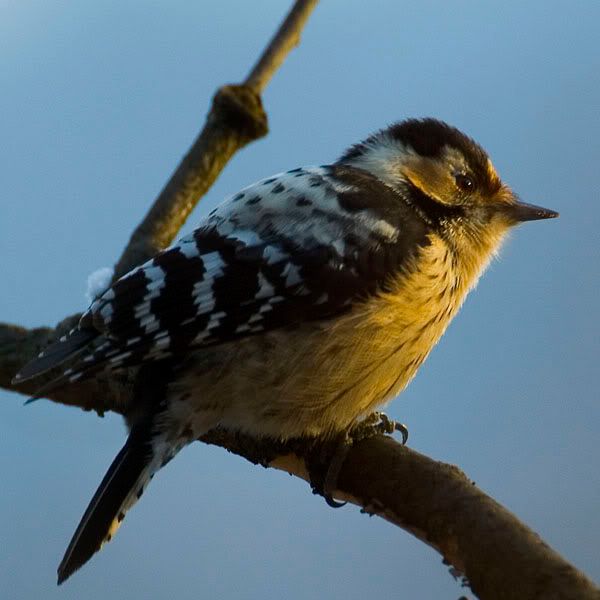 Adult female Lesser Spotted Woodpeckers are completely pied. That is, they are black and white. Thus they mainly differ from males in lacking red on the crown. However, a few females may show a tinge of pink at the rear of the crown and some may have faint red feather tips, but these are rarely visible in the field, only on birds in the hand. They have a buff forehead, dirty white fore-crown and black hind-crown. Some may have a brownish crown edged with black. Typical females have a white fore-crown edged with black that extends over the eye. Females have longer wings and longer tails than males but this is minimal and not noticeable in the field. This photo shows an adult female in Hungary (László Nehézy). Note the completely lack of any red.
Adult female Lesser Spotted Woodpeckers are completely pied. That is, they are black and white. Thus they mainly differ from males in lacking red on the crown. However, a few females may show a tinge of pink at the rear of the crown and some may have faint red feather tips, but these are rarely visible in the field, only on birds in the hand. They have a buff forehead, dirty white fore-crown and black hind-crown. Some may have a brownish crown edged with black. Typical females have a white fore-crown edged with black that extends over the eye. Females have longer wings and longer tails than males but this is minimal and not noticeable in the field. This photo shows an adult female in Hungary (László Nehézy). Note the completely lack of any red.
Lesser Spotted Woodpecker: adult male ID
Lesser Spotted Woodpecker: general ID
 Measurements: Length 14-16 cm. Wingspan 24-27 cm. Europe’s smallest woodpecker is just two-thirds the size of Great Spotted and Syrian Woodpeckers and around three-quarters the size of Middle Spotted Woodpecker. This species appears short-tailed and round headed in shape. It is the only European Dendrocopos woodpecker to lack red or pink colouration on the under-tail coverts and ventral area, which are white, spotted with grey-black. It is also "ladder-backed", lacking the white oval scapular patches of most other Dendrocopos woodpeckers. In fact, in terms of the black-and-white back pattern, Lesser Spotted most resembles White-backed Woodpecker. Black lower mantle, scapulars and upper rump barred white. Breast and belly whitish, with a suggestion of buff. White flanks and sides of breast generally finely streaked with black, but never to the extent of Middle Spotted Woodpecker. The black tips of the greater and some median wing-coverts are spotted white. Black flight feathers barred boldly white. Upper tail black, outer rectrices white with 2-3 black bars before tips. Sides of face, ear-coverts, chin and throat white. Black malar stripe runs from base of lower mandible to side of neck where it joins black lateral neck stripe and post-auricular stripe. A large black area is formed at this T-junction. The lateral neck stripe runs down onto the side of the breast. On the vast majority of birds the post-auricular stripe reaches only halfway or so across the ear-coverts and does not touch the black nape (this varies with race). Thus the reddish-brown eye (iris) is set in a large, open area of white. The bill is mostly grey-charcoal, with the base of the lower mandible paler, often lead coloured. It appears slight, pointed and rather weak. However, 12-18 mm long, it is in fact relatively large for the overall size of the bird. The legs are greyish-green. The photo shows an adult male at Chemnitz, Germany (Thomas Kraft).
Measurements: Length 14-16 cm. Wingspan 24-27 cm. Europe’s smallest woodpecker is just two-thirds the size of Great Spotted and Syrian Woodpeckers and around three-quarters the size of Middle Spotted Woodpecker. This species appears short-tailed and round headed in shape. It is the only European Dendrocopos woodpecker to lack red or pink colouration on the under-tail coverts and ventral area, which are white, spotted with grey-black. It is also "ladder-backed", lacking the white oval scapular patches of most other Dendrocopos woodpeckers. In fact, in terms of the black-and-white back pattern, Lesser Spotted most resembles White-backed Woodpecker. Black lower mantle, scapulars and upper rump barred white. Breast and belly whitish, with a suggestion of buff. White flanks and sides of breast generally finely streaked with black, but never to the extent of Middle Spotted Woodpecker. The black tips of the greater and some median wing-coverts are spotted white. Black flight feathers barred boldly white. Upper tail black, outer rectrices white with 2-3 black bars before tips. Sides of face, ear-coverts, chin and throat white. Black malar stripe runs from base of lower mandible to side of neck where it joins black lateral neck stripe and post-auricular stripe. A large black area is formed at this T-junction. The lateral neck stripe runs down onto the side of the breast. On the vast majority of birds the post-auricular stripe reaches only halfway or so across the ear-coverts and does not touch the black nape (this varies with race). Thus the reddish-brown eye (iris) is set in a large, open area of white. The bill is mostly grey-charcoal, with the base of the lower mandible paler, often lead coloured. It appears slight, pointed and rather weak. However, 12-18 mm long, it is in fact relatively large for the overall size of the bird. The legs are greyish-green. The photo shows an adult male at Chemnitz, Germany (Thomas Kraft).Tuesday, 18 September 2007
Quiz Woodpecker 1
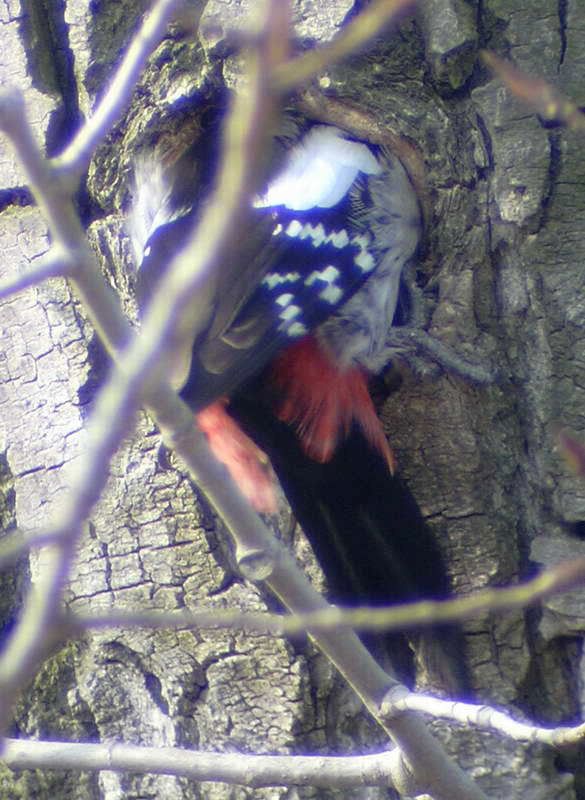 From time to time I will post a photo of a so-called "quiz bird", of course, always a woodpecker. This will allow you all to test your ID skills on a family of birds that, on the face of it, is not that difficult to ID, but which in the field (the woods) often only offer brief glimpses, take up unusual poses or are obscured by vegetation. The first in this series is here on the left. The ID sections in this blog should be enough to facilitate a correct ID. Good luck. And do let me know your answer.
From time to time I will post a photo of a so-called "quiz bird", of course, always a woodpecker. This will allow you all to test your ID skills on a family of birds that, on the face of it, is not that difficult to ID, but which in the field (the woods) often only offer brief glimpses, take up unusual poses or are obscured by vegetation. The first in this series is here on the left. The ID sections in this blog should be enough to facilitate a correct ID. Good luck. And do let me know your answer.
Friday, 14 September 2007
White-backed Woodpecker: juvenile lilfordi race ID
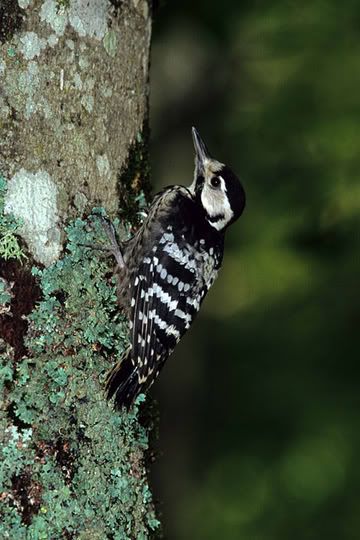 As is the case with the nominate leucotos, juveniles of the lilfordi race are not as glossy as adults, indeed they are sometimes rather brownish. Again, as with the nominate leucotos, they are sexually dimorphic from an early age, even when in the nest. White areas are dirtier, buffier than on adults. The pink under-tail and ventral region is smaller and paler than on adults and they are very heavily streaked on the body. Both sexes have red crowns (to varying extents) but this red is never as strong as on adults, being sometimes rather orange, edged with black and sometimes flecked with grey-black feather tips. Juvenile male lilfordi has a complete red crown that may extend to the black nape and sideways to the white cheeks. Males are longer billed and legged than sibling females but this only noticeable in the hand. Juvenile female lilfordi usually lack red on the crown. If any is present, then it is only on the fore-crown to central crown. There is always less red than on juvenile males. Sometimes just a few red tips to the black feathers can be seen. This photo is of a juvenile female lilfordi, in the Abruzzi Mountains, central Italy (Paul Harris).
As is the case with the nominate leucotos, juveniles of the lilfordi race are not as glossy as adults, indeed they are sometimes rather brownish. Again, as with the nominate leucotos, they are sexually dimorphic from an early age, even when in the nest. White areas are dirtier, buffier than on adults. The pink under-tail and ventral region is smaller and paler than on adults and they are very heavily streaked on the body. Both sexes have red crowns (to varying extents) but this red is never as strong as on adults, being sometimes rather orange, edged with black and sometimes flecked with grey-black feather tips. Juvenile male lilfordi has a complete red crown that may extend to the black nape and sideways to the white cheeks. Males are longer billed and legged than sibling females but this only noticeable in the hand. Juvenile female lilfordi usually lack red on the crown. If any is present, then it is only on the fore-crown to central crown. There is always less red than on juvenile males. Sometimes just a few red tips to the black feathers can be seen. This photo is of a juvenile female lilfordi, in the Abruzzi Mountains, central Italy (Paul Harris).
White-backed Woodpecker: female lilfordi race ID
White-backed Woodpecker: male lilfordi race ID
White-backed Woodpecker: lilfordi race general ID
The general features described elsewhere in this blog for nominate leucotos apply equally to the southern European race lilfordi. However, there are some striking and important differences in plumage that together with wing and bill measurements, voice, habitat selection and distribution, have resulted in this race sometimes being considered a separate species i.e. Lilford’s Woodpecker. Lilfordi is slightly larger, overall darker and more heavily streaked with long, black, flecks on the flanks, breast and belly. In addition to vertical streaks there are also some horizontal bars on the flanks that nominate lacks. The pink ventral area extends further up onto the belly than leucotos, often onto the lower breast. Under-parts various shades of white, cream, often dusky or tinged buff and always more marked and darker than leucotos. The forehead, lores, cheeks and throat are also more yellow. The black post-auricular stripe and malar stripe are broader and, where they join to form a T-junction, below the ear-coverts, a larger black area is formed. Face patterns may vary slightly from bird to bird but on all the post-auricular stripe runs over the ear-coverts and finishes much closer to, or even touches, the nape. On leucotos it never touches the nape and a wider white gap is clear. Wings have narrower white bars than on nominate. But above all lilfordi lacks the clear white lower-back and upper rump patch of leucotos race. Lilfordi is thus less "white-backed" than leucotos. It is rather "barred-backed" or perhaps "ladder-backed" due to the white-back and upper-rump being vermiculated with black. The rump of this race often seems totally black.
White-backed Woodpecker: juvenile female ID
Juvenile female White-backeds have red colouration only on the fore-crown (adult female has none) but this often rather patchy, and always less than on juvenile male. Sometimes this patch is merely a few red or pink feathers. The true extent of red on the crown becomes evident some twelve days after hatching.
White-backed Woodpecker: juvenile male ID
Juvenile male White-backeds have an all red crown which extends at the back of the head to the black nape and sideways to the white cheeks. This becomes apparent around twelve days after hatching and is more pronounced as birds peep out of the hole prior to fledging. Male fledglings are generally heavier, and have longer bills and tarsi than sibling females though these factors only noticeable in the hand.
White-backed Woodpecker: juvenile ID
 Juvenile White-backed Woodpeckers are sexually dimorphic whilst still in the nest. It takes around seven months (i.e. into the winter following fledging) for juveniles to attain full adult plumage. Juveniles are duller and browner than adults and black areas matt rather than glossy. White areas are greyer, dirtier than on adult and there is often a grey smudge over the ear-coverts and behind eye (similar to that on juvenile Syrian Woodpecker). The pink ventral region is smaller and paler than on adults and the dark streaks on the under-body are more diffuse. Both male and female juveniles have red on the crown (see other posts) but they are not as strong in colour as on adult males. The red crown is sometimes rather rusty and with grey or black flecks. Bare parts are grey. The photo here shows a fledging female at Varmland, Sweden, taken in May 1994 (Göran Ekström). Note that there is only a hint of pink on the forecrown on this bird.
Juvenile White-backed Woodpeckers are sexually dimorphic whilst still in the nest. It takes around seven months (i.e. into the winter following fledging) for juveniles to attain full adult plumage. Juveniles are duller and browner than adults and black areas matt rather than glossy. White areas are greyer, dirtier than on adult and there is often a grey smudge over the ear-coverts and behind eye (similar to that on juvenile Syrian Woodpecker). The pink ventral region is smaller and paler than on adults and the dark streaks on the under-body are more diffuse. Both male and female juveniles have red on the crown (see other posts) but they are not as strong in colour as on adult males. The red crown is sometimes rather rusty and with grey or black flecks. Bare parts are grey. The photo here shows a fledging female at Varmland, Sweden, taken in May 1994 (Göran Ekström). Note that there is only a hint of pink on the forecrown on this bird.
White-backed Woodpecker: adult female ID
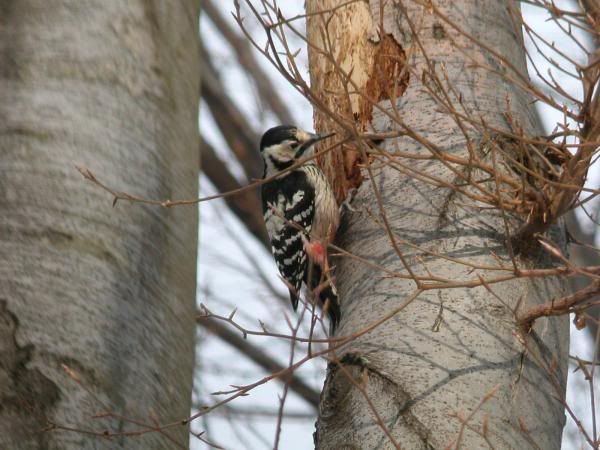 Adult female White-backed Woodpeckers lack the red crown of males. The complete crown from forehead to nape is black. Overall females are slightly smaller than males and their bill is slightly shorter, but these features are not really noticeable in the field. This photo of an adult female leucotos was taken in the Bakony Hills, Hungary (Gábor Vasuta).
Adult female White-backed Woodpeckers lack the red crown of males. The complete crown from forehead to nape is black. Overall females are slightly smaller than males and their bill is slightly shorter, but these features are not really noticeable in the field. This photo of an adult female leucotos was taken in the Bakony Hills, Hungary (Gábor Vasuta).
White-backed Woodpecker: adult male ID
 As is the case (though to varying degrees) with other "pied" woodpeckers in Europe, White-backed males are slightly heavier, bigger and have longer bills than females. Bill length is the most significant morphological feature in terms of sexual dimorphism, but is not rarely noticeable in the field and only when a pair is seen together. The all red crown is the main feature distinguishing males from females (which lack red on the head). Sometimes these red feathers have visible dark bases. On some males the pink of the under-tail coverts and vental area reaches as far as the lower belly, lower flanks and leg feathering. On females it is usually less extensive, though this is variable. The photo here is of an adult male leucotos in Estonia, taken on 2.4.2005 (Uku Paal).
As is the case (though to varying degrees) with other "pied" woodpeckers in Europe, White-backed males are slightly heavier, bigger and have longer bills than females. Bill length is the most significant morphological feature in terms of sexual dimorphism, but is not rarely noticeable in the field and only when a pair is seen together. The all red crown is the main feature distinguishing males from females (which lack red on the head). Sometimes these red feathers have visible dark bases. On some males the pink of the under-tail coverts and vental area reaches as far as the lower belly, lower flanks and leg feathering. On females it is usually less extensive, though this is variable. The photo here is of an adult male leucotos in Estonia, taken on 2.4.2005 (Uku Paal).
Subscribe to:
Posts (Atom)











